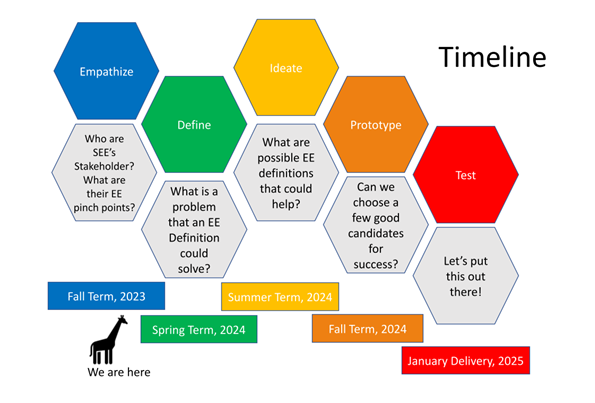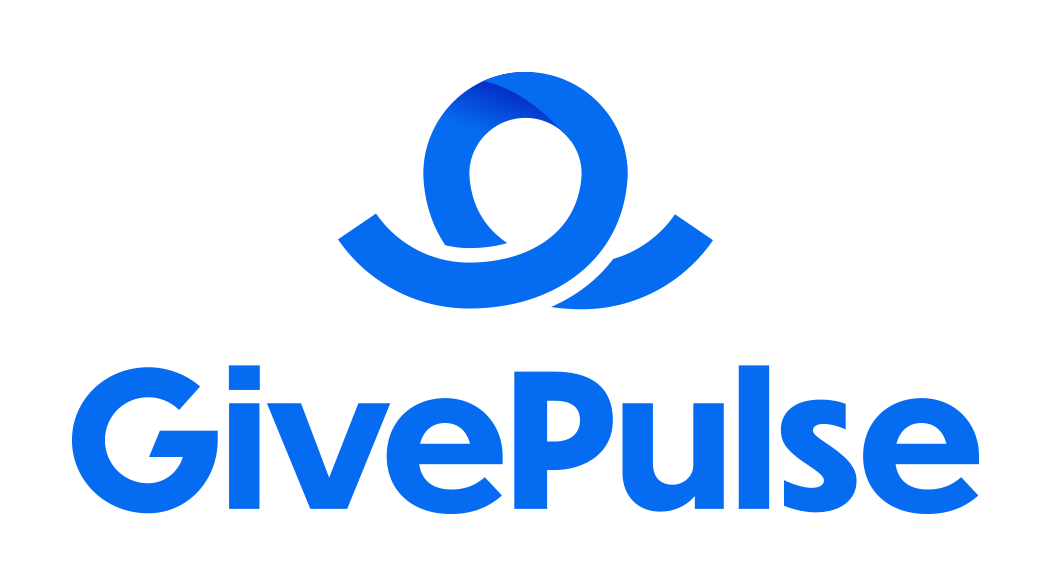 |
 |
 |
The Society for Experiential Education Definitions and Principles Design ProjectPhase 1 Summary
Bill Heinrich and Patrick Green
In co-chairing this process we began a design process to lead the Society of Experiential Education (SEE) toward a new definition of Experiential Education and updated principles of practice, at the request of the Board of SEE. In the context of advancements in experiential education through the lens of new research, updated conceptual frameworks, novel models of practice, and broad institutionalization across higher education, the Board of SEE requested that the Research and Scholarship Committee explore and articulate an updated definition and principles of practice. This request led to a plan for a design process that incorporates the insight and experience of practitioners and scholars across experiential education programs and contexts. You might notice some tentative language in this summary as we are in the first of five stages of a design process, and we are circumspect now about knowing what the process will yield in 12 more months. That being said, we engage this reflective process with open minds and community-engaged posture. 
We’re modeling a process on IDEO’s human-centered design phases. It’s a simple and robust method focusing on developing solutions in service of people. It provides a fairly functional framework that people can follow, and serves as a map of both progress and reflection. This toolkit explains the process, in abstract. The project phases begin with Empathy building, understanding a common definition of a problem, ideation/brainstorming, prototyping, and testing. We anticipate an iterative cycle of data, sensemaking, and reflection in each phase. The phases are planned in consideration of academic breaks and common work times (i.e. semesters). The test will be the published updated definition and principles. Here are our operating principles. The HCD process includes five smaller investigations or inquiries. Since we aim to share our knowledge, we have established a research project hosted by University of Dayton, led by Dr. Karen Velasquez, and Dr. Michael Odio from the University of Cincinnati. Because this project will progress and change over time, we include the following outline, created in June, 2023, as an historical note. Sharing our thinking helps us remain transparent and reflective about how our thinking about the process of developing a new definition and updating principles changed from our initial plans, and how the outcome of the process is informed by many people and organizations with an interest or perspective.
i. engaged learning faculty
ii. community partners/campus partners iii. accreditors, regional and topical iv. SEE leaders are one group of stakeholders
Another layer of sharing this outline is that we expect our thinking to change. We will document changes along the way and do our best to acknowledge how our reflections and discussions led us to change our paths. This public iterative process, we believe, is essential to an engaging and useful outcome. Finally, to create an inclusive and welcoming conversation at all points, we’ve adopted some principles of action in this process. We want to create a definition and updated principles that are welcome and ultimately informative to SEE members and other experiential educators. The attempts here to document our process serve as a reminder of our commitments to sharing our work as we go through this process.
The Society for Experiential Education Definitions and Principles Design Project Phase 2 Summary For context, the Society of Experiential Education (SEE) Board has commissioned the Research and Scholarship Committee to engage in the process of exploring an updated definition of Experiential Education and updated principles of practice. See Phase 1 Summary for background on the genesis and early steps in this process: https://www.societyforee.org/see-definitions-principles-project. Phase 2. January-June 2024
The goals in phase 2 were to first, review and discuss phases 1 & 2 data and insights, and second, to gather feedback on a proposed Problem Statement. As with many human-centered design driven projects, stakeholder data collected in phase 1 informed the definition of the problem in phase 2. Phase 1 stakeholder data collection focused on needs for an experiential learning (EL) definition and principles of practice. Stakeholders were broadly engaged, including various faculty and educational administrators in higher education, partner organizations that compose SEE membership, and members of other professional organizations committed to and engaged with experiential education. We asked what problem would a definition solve, and for whom? We gathered feedback and insights from the stakeholders in response to these questions through an iterative dialogue process in monthly meetings. In phase 2, we began to organize data into categories and themes to develop insights, and later, problem statements. Our analyses of stakeholder data revealed three key foundations for a definition and framework for EL, which serve as pillars for this work:
When we arranged data by stakeholders and their needs, we began to see clustering into groups. Our analyses articulated categories of stakeholders engaged and invested in experiential learning:
Our analyses then revealed needs held by these stakeholders:
We created two images to show our understanding of the arrangement of Experiential Learning work and the stakeholders involved. First we see generalized arrangements of internal stakeholders related to EL work. A key insight here is the presence of and operations emerging around a campus-wide Experiential Learning Ecosystem, which provides an overview of internal campus stakeholders interested in and directly impacting experiential learning. Experiential Learning Ecosystem
Next we see an overlay of hypothetical interactions with external stakeholders on top of internal stakeholders. Our key insight here is the role external stakeholders play in driving priorities and decisions, highlighting a need for shared meaning in an ecosystem to better communicate about the purpose, values, and mission of Experiential Learning. The heuristic clearly communicates the many stakeholders and the complexity of the Experiential Learning Ecosystem, which calls for shared meaning in each specific institutional context. Interactions in the Experiential Learning Ecosystem
Throughout the iterative process of reviewing and engaging the data with stakeholders, we then built on these insights to propose problem statements that a SEE definition and principles project might address. We drafted and pitched these problem statements to stakeholders in May and June of 2024. These statements reflect refined versions following significant stakeholder engagement, challenges, questions, feedback, suggestions, edits, and clarifications. We pose these problem statements in three groups. Group 1. Experiential Learning Ecosystem
Group 2. Sustainability and Scale
Group 3. Multidimensional experiences lead to rich data
In conclusion, as we continue the design process, our collective task is next to clarify our understanding of these challenges through the ongoing iterative process. We then begin phase 3 where we generate ideas (ideation) that might solve for the challenges (problem statements) summarized here. No idea is too big right now, and all ideas are welcome during the ideation phase. We will continue to invite all stakeholders to engage in this iterative process as we move through the design phases. The Society for Experiential Education Definitions and Principles Design Project Phase 3 Summary For context, the Society of Experiential Education (SEE) Board has commissioned the Research and Scholarship Committee to engage in the process of exploring an updated definition of Experiential Education and updated principles of practice. See Phase 1 Summary for background on the genesis and early steps in this process and Phase 2 for problem definition and needs summaries: https://www.societyforee.org/see-definitions-principles-project. Phase 3. June-October 2024 Phases 1 & 2 Review (ICYMI) As with many human-centered design driven projects, stakeholder data collected in phase 1 informed the definition of the problem in phase 2. Phase 1 stakeholder data collection focused on needs for an experiential learning (EL) definition and principles of practice. Stakeholders were broadly engaged, including various faculty and educational administrators in higher education, partner organizations that compose SEE membership, and members of other professional organizations committed to and engaged with experiential education. We asked what problem would a definition solve, and for whom? We gathered feedback and insights from the stakeholders in response to these questions through an iterative dialogue process in monthly meetings. In Phase 2, we began to organize data into categories and themes to develop insights, and later, problem statements and an ecosystem model for shared understanding:
Experiential Learning Ecosystem These problem statements were informed by the data collected in Phase 1 and the iterative feedback process. In conclusion, as we continue the design process, our collective task is next to clarify our understanding of these challenges through the ongoing iterative process. The iterative process in each phase includes ongoing feedback through committee meetings, board meetings, and general membership meetings of SEE, as well as external stakeholders. We then begin phase 3 where we generate ideas (ideation) that might solve for the challenges (problem statements) summarized here. In the Phase 3 of Ideation, no idea is too big right now, and all ideas are welcome during the ideation phase. We will continue to invite all stakeholders to engage in this iterative process as we move through the design phases. Phase 3: Ideation The goals in phase 3, Ideation, were first, to build upon and discuss stakeholder needs and problem statements from phases 1 & 2; and second, to solicit ideas for solutions to the problems stated in Phase 2. We met with five different groups of stakeholders including the SEE Research & Scholarship Committee, The SEE Board of Directors, and several open invitations to the SEE membership. Responses to the Ideation prompts were diverse and wide ranging, as are the stakeholders of definitions and principles of Experiential Education. Here are some examples with initial coding (highlighted).
Collecting ideas is a broadening idea, casting a wide net to foster access to the design process, as well as to capture concepts. The collection of ideas was grounded by SEE and the project values of inclusion, diversity, broad access, and a focus on learning. We engaged 67 individual contributors in the ideation phase, yielding hundreds of ideas and solutions for a definition. We are clustering and aggregating ideas to create models and prototypes (phase 4). Initial analyses of ideas provided by stakeholders is underway in November, 2024, and acknowledges a multi-dimensional understanding of experiential learning. We are viewing these ideas through the lens of the ecosystem model established in the needs analysis of phases 1, 2. The resulting analyses has yielded the first (imperfect) prototype of a definitional framework: EL is Pedagogy, Philosophy, & institutional Strategy
One size does not fit all, please adapt to your context
Conclusion The ongoing design work is advancing toward a set of decisions based on the ongoing engagement and feedback from stakeholders. Phase 4 will produce more prototypes of definitions and principles of experiential education for review by stakeholder groups in the early part of 2025. |
|||||||||||||||||||||||||||||||||||||||||||||
| Last Updated on Friday, November 15, 2024 01:03 PM |





